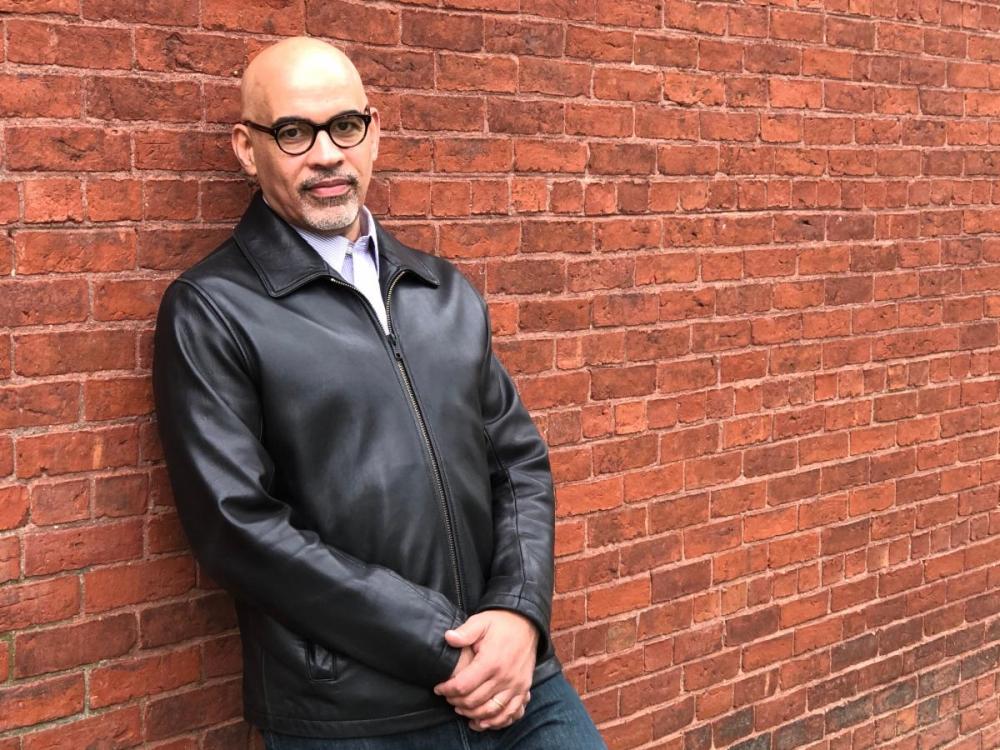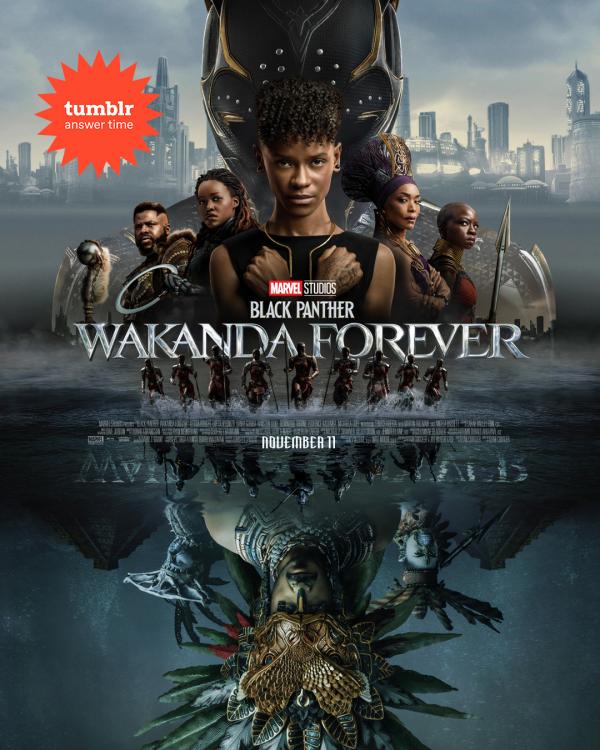-
Posts
2,392 -
Joined
-
Last visited
-
Days Won
90
Content Type
Profiles
Forums
Blogs
Events
Status Replies posted by richardmurray
-

The CBL Staff Wishes You a
Joyous Holiday Season!
We're reflecting on 2022 and giving thanks for a highly productive year. Most outstanding is the success of our 20th Anniversary Jubilee Celebration on October 20. It is our honor to share a bit of the magic from that night with those who weren’t able to attend.
Please enjoy these inspirational
welcoming remarks from our friend
Sonia Sanchez
As 2022 closes, we know that many of you are working on your year-end giving plans to nonprofit organizations. Did you know that CBL relies on donations from the community to thrive? Our year-round literary programs and special events need your financial support.
We hope we can count on you to help make 2023 our best year ever! If so, please donate what you can by Saturday, December 31, 2022.
Donate HERE < https://www.rfcuny.org/eventpayment/events/index?college=medgar > (via Research Foundation CUNY aka RFCUNY).
Have a wonderful holiday season. Enjoy your end-of-year celebrations!
~ Team CBL
The Canvas Institute invites the community to the opening reception of the art exhibition titled Someone Like Me, featuring the Beverly Moorehead Doll Collection. This event will be hosted by Dr. Brenda M. Greene, executive director of the Center for Black Literature at Medgar Evers College, and the exhibit's curation team, Sadé Dinkins and Teresa Caliari.
The exhibit takes the viewer on a symbolic journey through a life-sized doll house. Composed of different themed "rooms" and a wide variety of dolls, this exhibit has something for all ages, backgrounds, and identities.
Someone Like Me Exhibit
Opening Reception
Saturday, December 10, 2022
2:00 pm
at Canvas Institute
150 Victory Boulevard
Staten Island, NY
To RSVP for the reception, contact
Sadé Dinkins at shadink@gmail.com
THE WINTER 2023 RETREAT
AT-A-GLANCE
Novelist Kia Corthorn and poet Willie Perdomo are the faculty members for the Winter 2023 four-day retreat at Medgar Evers College (Brooklyn, NY).
The dates are February 23 - 26, 2023. Aspiring writers (21 and over) are encouraged to apply.
The application is downloadable < https://centerforblackliterature.org/wp-content/uploads/2022/12/WSRWC2023_4WEB_Application_Winter.pdf > (online version coming soon).
We Are Thrilled to Welcome
WILLIE PERDOMO
-- New York State Poet Laureate --
as a Returning Faculty Member
for the Wild Seeds Retreat
for Writers of Color (Winter 2023)
ABOUT THE RETREAT
The Wild Seeds Retreat for Writers of Color provides a writing community where established and emerging writers can focus on the craft of writing and create cross-cultural conversations around the literature created by writers of the African diaspora. Writing fellows have an opportunity to draw upon their experiences as writers in a racialized society; to become knowledgeable about the issues facing other writers of color; and to study with a professional in the genres of fiction, memoir, and poetry.
ABOUT THE FACULTY MEMBER
Willie Perdomo is the author of Smoking Lovely: The Remix (Haymarket Books, 2021), The Crazy Bunch (Penguin Random House, 2019), The Essential Hits of Shorty Bon Bon (Penguin Random House, 2014), and Where a Nickel Costs of Dime (Norton, 1996). Winner of the Foundation for Contemporary Arts Cy Twombly Award for Poetry, the New York City Book Award in Poetry, and the PEN Open Book Award, Perdomo was also a finalist for the National Book Critics Circle Award, and the Poetry Society of America Norma Farber First Book Award.
He is co-editor of the anthology, Latínext, and his work has appeared in The New York Times Magazine, Poetry, Washington Post, The Best AmericanPoetry 2019, and African Voices. Perdomo is currently a Lucas Arts Literary Fellow, a core faculty member at VONA/Voices of our Nation Writing Workshop, and teaches at Phillips Exeter Academy. | Source: www.willieperdomo.com
-
Title: Scourged back by McPherson & Oliver, 1863, retouched
Description: Scars of a whipped Mississippi slave, photo taken April 2, 1863, Baton Rouge, Louisiana, USA. Original caption: "Overseer Artayou Carrier whipped me. I was two months in bed sore from the whipping. My master come after I was whipped; he discharged the overseer. The very words of poor Peter, taken as he sat for his picture."
NOTE: The New York Times writer Joan Paulson Gage, noted, "The images of Wilson Chinn in chains, like the one of Gordon and his scarred back, are as disturbing today as they were in 1863. They serve as two of the earliest and most dramatic examples of how the newborn medium of photography could change the course of history." [ read the second article below ]
Will Smith Responds to People Who Reject His Comeback So Soon After Oscars Slap: ‘I Completely Understand’By Zack Sharf
Will Smith’s press tour for “Emancipation” has begun, with the actor directly addressing moviegoers who are not yet ready to embrace his work following the Oscars slap earlier this year. “Emancipation,” a slavery drama directed by Antoine Fuqua, is Smith’s first major film release since the 2022 Oscars, where he took the stage and slapped presenter Chris Rock across the face over a joke made at the expense of Smith’s wife, Jada Pinkett Smith.
“I completely understand — if someone is not ready, I would absolutely respect that and allow them their space to not be ready,” Smith told journalist Kevin McCarthy when asked what he would say to moviegoers who aren’t ready for his comeback. “My deepest concern is my team – Antoine has done what I think is the greatest work of his entire career. The people on this team have done some of the best work of their entire careers, and my deepest hope is that my actions don’t penalize my team. At this point, that’s what I’m working for.”
Smith added, “I’m hoping that the material — the power of the film, the timeliness of the story — I’m hoping that the good that can be done would open people’s hearts at a minimum to see and recognize and support the incredible artists in and around this film.”
“Emancipation” is based on a true story and stars Smith as a runaway slave named Peter, known better to the world as “Whipped Peter” after photographs of keloid scarring on his back were distributed to show the brutality of slavery. The film follows Peter as he navigates the swamps of Louisiana to escape the plantation owners that nearly killed him.
In an interview earlier this month with Vanity Fair, director Antoine Fuqua defended releasing “Emancipation” in the same year as Smith’s Oscars slap.
“The film to me is bigger than that moment,” Fuqua said. “Four hundred years of slavery is bigger than one moment. My hope is that people will see it that way and watch the movie and be swept away with the great performance by Will and all the real hard work that the whole crew did.”
According to Fuqua, committing to release the movie in 2022 was “a full conversation with Apple” but “there was never a conversation with me and Apple or my producers about the movie not coming out.”
“Of course I wanted people to see the film,” Fuqua said. “My conversation was always, ‘Isn’t 400 years of slavery, of brutality, more important than one bad moment?’ We were in Hollywood, and there’s been some really ugly things that have taken place, and we’ve seen a lot of people get awards that have done some really nasty things. So I think Apple considered all those things, and we discussed a lot of those things. Then a decision was made by the people in charge of distribution and the money at Apple — and I’m grateful, I’m really grateful.”
“Emancipation” premieres in theaters on Dec. 2 and will stream on Apple TV+ starting Dec. 9.
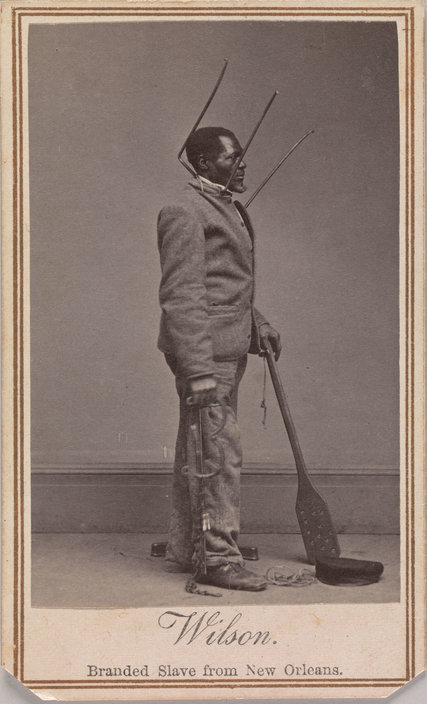
"Wilson. Branded Slave from New Orleans," 1863, taken by Charles Praxson.Credit Private Collection, Courtesy William L. SchaefferIcons of Cruelty
BY JOAN PAULSON GAGE AUGUST 5, 2013 12:45 PMTwo iconic photographs of former slaves documenting the torture inflicted on them by their owners were widely circulated during the Civil War as anti-slavery propaganda, and both appear in the current exhibit “Photography and the American Civil War” at the Metropolitan Museum of Art. Although the images were extensively reproduced and helped to turn public opinion against slavery, the stories of the two men in these shocking photographs are little known today.
Perhaps the most famous anti-slavery image ever made is “The Scourged Back,” in which an escaped slave named Gordon poses to reveal the web of raised scars covering his body. An engraving of this photograph, attributed to McPherson and Oliver of New Orleans, was published on July 4, 1863, in Harper’s Weekly, along with the explanation that Gordon had escaped his master in Mississippi and threw the pursuing bloodhounds off his scent by rubbing himself with onions. After an arduous journey, he managed to reach the Union Army stationed at Baton Rouge, La., 80 miles away.
Gordon decided to enlist in the Union Army — something that President Lincoln had legalized only months earlier — and during the required medical examination, the officers saw his back “furrowed and scarred with the traces of a whipping administered on Christmas Day last.” They called for a photographer to document it. On April 16, 1863, S. K. Towle, surgeon, 30th Regiment, Massachusetts Volunteers, sent a C.D.V. (carte de visite) photograph of Gordon’s back with a letter to W. J. Dale, surgeon general of the state of Massachusetts. He wrote: “Few sensation writers ever depicted worse punishment than this man must have received, though nothing in his appearance indicates any unusual viciousness — but on the contrary he seems INTELLIGENT AND WELL BEHAVED.”
The Harper’s article also included an engraving of “Gordon in his uniform as a U.S. Soldier,” holding his musket. Little is known of Gordon’s military career. One published report said that he served as a sergeant in a black regiment that fought bravely at the siege of Port Hudson on May 27, 1863 — the first time that African-American soldiers played a leading role in an assault.
Meanwhile, the photograph of Gordon’s scars took on a life of its own as a weapon of the abolitionists. It was reproduced and sold in the carte-de-visite form by C. Seaver of Boston; by McAllister of Philadelphia, who first titled it “The Scourged Back”; and by other American photographers, including Mathew Brady. Another version was issued by a British publisher, titled “The ‘Peculiar Institution’ Illustrated”; an ironic reference to the euphemism for slavery used by Southerners.
On the back of the British version were printed remarks from newspapers, including this from The New York Independent: “This Card Photograph should be multiplied by the 100,000, and scattered over the States. It tells the story in a way that even Mrs. [Harriet Beecher] Stowe [author of ‘Uncle Tom’s Cabin’] cannot approach, because it tells the story to the eye.”
While the photograph of Gordon’s back may first have been made as a clinical document and then turned into propaganda, the C.D.V. photograph of Wilson Chinn with chains and torture instruments was from the start meant to excite anti-slavery emotion.
In December of 1863, eight former slaves were brought north from New Orleans, sponsored by the American Missionary Association and the National Freedman’s Relief Association. They were taken to photographers’ studios in New York and Philadelphia and posed in dramatic scenes for photographs, which were sold for 25 cents each to raise money for the education of former slaves in Louisiana. The other purpose of these photographs was to increase abolitionist sentiment in the North by using the fledgling science of photography to dramatize the evils of slavery.
Five members of the group were children aged from 6 to 11 — three girls and two boys — and four of them were so fair-skinned that they appeared entirely Caucasian, although all five had been born as slaves. The only adult in the series of photos, which were made by Myron H. Kimball and Charles Paxson of New York and J. E. McClees of Philadelphia, was Wilson Chinn, identified on most of the photographs as “a branded slave.”
On Jan. 30, 1864, Harper’s Weekly published a large engraving of the group portrait. In an article titled “Emancipated Slaves White and Colored,” Harper’s introduced each individual. Here’s the paragraph about Chinn:
“Wilson Chinn is about 60 years old. He was ‘raised’ by Isaac Howard of Woodford Country, Kentucky. When 21 years old he was taken down the river and sold to Volsey B. Marmillion, a sugar planter about 45 miles above New Orleans. This man was accustomed to brand his negroes, and Wilson has on his forehead the letters ‘V.B.M.’ Of the 210 slaves on this plantation 105 left at one time and came into the Union camp. Thirty of them had been branded like cattle with a hot iron, four of them on the forehead, and the others on the breast or arm.”
(The letters branded on Wilson’s forehead were not clear in the photograph, and the photographer, Kimball, had to retouch the negative to make them visible.)
The Northern photographers posed the children in fine clothes and sentimental poses with titles like “Oh! How I Love the Old Flag” and “Our Protection.” Wilson Chinn was posed in one scene, “Learning Is Wealth,” apparently reading a book to three of the fair-skinned children. But his other photos were meant to illustrate the savagery of the treatment of slaves. He was posed by Paxson in profile in the C.D.V. from the Met’s exhibit wearing a spiked collar and leg irons and holding a nail-studded paddle. (There exist at least two other versions — a frontal view by Kimball with the paddle on the floor and a third, also by Kimball, in which the instruments of torture are all on the floor. Wilson stands with his left foot atop the paddle — no doubt symbolizing that he is now free.)
The grisly images of Wilson wearing the spiked collar are the rarest and most valuable. In 2002 one of the Kimball C.D.V.’s sold on eBay for $1,846.
Jeff L. Rosenheim, the Met’s curator of photographs, wrote in the catalog for “Photography and the American Civil War” that he found the Wilson Chinn photo especially puzzling: “Paxson No. 8, Wilson Branded Slave from New Orleans … is a bewildering instance of Civil War photographic marketing that asks as many questions about the individuals who commissioned the portraits as it does about those who would purchase or collect these images.”
Undoubtedly Wilson Chinn, and even the children who traveled with him from New Orleans, knew that their role in coming North was to dramatize the evils of the “peculiar institution” from which they had recently escaped.
The images of Wilson Chinn in chains, like the one of Gordon and his scarred back, are as disturbing today as they were in 1863. They serve as two of the earliest and most dramatic examples of how the newborn medium of photography could change the course of history.
ARTICLE
https://archive.nytimes.com/opinionator.blogs.nytimes.com/2013/08/05/icons-of-cruelty/ -
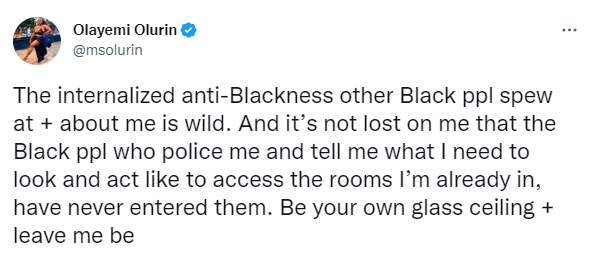
My Reply
Bill T Jones once said, on Bill Maher's show, he was chided in the 1960s for a performance by other black people, and he said he thought the movement was about individual liberty.
But, what many Black people or other population minorities in the USA don't see/comprehend/know/admit is that the majority in all minority groups are not fighting to get individual liberties for all, but they are fighting to get majority liberties in their minority.
When the war between the states ended, the Black community was courted by white christian protestant groups for various reasons. But it made a hard space for Black agnostics or atheist or traditionalist <spiritual or religious beliefs brewed in the Black community during enslavement before the war between the states ended that are not christian ,ala Daughters of the Dust grandmother> . Frederick Douglass , a mulatto< a person with a phenotypically white parent plus black parent>, I feel was opposed to publicly supporting other options for Black DOS, <descendend of enslaved> who represented over ninety percent of the black populace in the usa at that time, largely in part because he knew all other options: a state in the union/leaving to canada or africa or haiti went against individual liberty growing in the black community. Which he himself needed as he had a white mistress and many Black people at that time, a recently completely enslaved people to whites , frowned on that.
Many Black people felt and some feel the Black community was used in the 1960s. The civil rights act was never meant to be an individual liberties act, which is what it is. It was meant to be a leveller for Black DOSers originally. But, the party of Andrew Jackson saw an opportunity to gain many votes by expanding the civil rights act to women/jews/asians or all non white european male christians, not merely Black DOSers, who sadly did die more than many others minorities for that civil rights act to be.
So, Olayemi's point is correct save one thing. It isn't internalized anti-Blackness as much as anti-minority. In USA history, Black used to mean , DOSers, over ninety percent. But, USA immigration policy with the immigration act of 1965 had a tremendous effect on the majority in all communities in the USA. The white communities Anglo Saxon Protestant majority already dealt with catholics or italy/ireland plus eastern european jews before joining the white community. But now, white latinos/whites of africa are coming in droves into the white community of the USA in such numbers they don't just merge into the WASP, they are their own. MArcus Garvey was from the english imperial island of Jamaica but now, the Black DOS community has to deal with Nigerians/Jamaicans/Haitians/Trinidadians/Ghanians/South Africans/Siddi of India plus other Black Asians of South East Asia in such numbers they don't merely absorb in the DOS community , they are on their own. The Asian community was once majority Han Chinese, white asians, by far, but now you have Bangladeshi/Indonesians/filipinos/iranians/pakistani in large numbers that being asian american can not be synonymous with the chinese anymore and the chinese american tradition of governmental non involvement is no longer the standard. LAtin American used to be Mexican , mostly mestizo, in the west coast and Puerto Rican, mostly blanco, in the east coast but now it is colombian/venezuelan/ecuadorian/chilean/ bolivian and not all blanco but also mulatto also negra also indio , meaning native american, so the complexity has risen and thus latino voting patterns seem all over the place.
All majorities in pen-population the USA, the native american in the usa is unique, before the 1960s have been reduced in potency by the individual liberties set in by the 1960s civil rights act and the immigration policy of the 1960s immigration act. So much so that the entire usa population as well as its parts: blacks/whites/women/latinos/christians/muslims plus all others are dealing with a plurality majority future that the former majorities didn't want, have not embraced for the most part, and thus the frictions in social media.
Bill T Jones a black man, legendary dancer, who is a member of one in the LGBTQ+ was fighting for Black empowerment as a subset of human empowerment. I paraphrase Sidney Poitier's character in guess whose coming to dinner: "you see yourself as a black human, I see myself as a human"
This is why MLK jr was so beloved by so many outside the Black community or so many minorities in the Black community. He was a Black christian preacher whose position was individual liberty. So he can get Black people who might not listen to a muslim- malcolm- or a jamaican- garvey - or a woman- fannie lou hamer- to march with him. But it is also why Black Militants/Segregationist had huge issues with MLK because they tend to not accept individual liberties. In the same way the KKK , while for white power, wasn't interested in white women voting or white members of the lgbtq+ having any protection or say or rights or white asians or white latinos being considered equals to anglo saxon protestants.
The issue isn't anti -yourself. The issue is anti- minority,which minority groups have within themselves.
Olayemi's prose closes with the fundamental idea of individual liberty. The only community that matters is the human. Those who support individual liberty fight for communities, like Olayemi or Bill T Jones in the context of greater individual liberty or freedom or protection. Unfortunately, in the Black community in the USA , this is not full explained or comprehended by many Black people.
I am not suggesting I support individual liberty universally, because I don't. But I comprehend it. And I don't have a problem with Black people whose actions reflect it.referral
[ https://twitter.com/msolurin/status/1596202896399687680 ] -
Any writers in here with zero or near zero drawing capability want a chance to have a complex logical process, commonly called, an Artificial Intelligence, compose a work of art for them?
I am considering making a group in deviantart for you writers. Writers who also draw, like me, your not welcome for now. For now, just the writers who can't draw
https://www.deviantart.com/hddeviant/art/Dreamupgif-937250338
-
Any writers in here with zero or near zero drawing capability want a chance to have a complex logical process, commonly called, an Artificial Intelligence, compose a work of art for them?
I am considering making a group in deviantart for you writers. Writers who also draw, like me, your not welcome for now. For now, just the writers who can't draw
https://www.deviantart.com/hddeviant/art/Dreamupgif-937250338
-

Various constitutional amendments prohibit denying voting rights to women, racial minorities and other groups. But the Constitution contains no explicit right to vote.Credit...Jonah Markowitz for The New York TimesDoes the Constitution Guarantee a Right to Vote? The Answer May Surprise You.
For decades, the courts and Congress have taken the lead in expanding the legal right to vote, but the founders never explicitly included it.By Michael Wines
Oct. 26, 2022
The Constitution makes reference to voting 15 times in the original document and another 22 in the amendments. But somewhat surprisingly, none of those mentions makes an explicit declaration that Americans have a right to vote — something many politicians and their supporters consider fundamental to democracy. Here’s a look at why that is, and what rights voters actually have.What did the founding fathers believe about the right to vote?
If it seems odd that such a fundamental right was not enshrined in writing, the explanation is simple enough: The authors of the Constitution, many of them deeply suspicious of universal suffrage, could not agree on a single standard for the right to cast a ballot.For all their talk about “We, the people,” most of the founding fathers wanted to limit voting rights to property owners like themselves, the Harvard law professor and historian Michael J. Klarman wrote in his 2016 book “The Framers’ Coup: The Making of the United States Constitution.”
Gouverneur Morris, a New Yorker who wrote the preamble to the Constitution, argued that “the ignorant and the dependent can be as little trusted with the public interest” as could children, Dr. Klarman wrote. James Madison warned that voting should be restricted to the wealthy, “the safest repositories of republican liberty,” because the poorer classes would be swayed by populist appeals. Benjamin Franklin, the most prominent dissenter, pointed out that it was the commoners who had fought for and won American independence and that the rich were hardly immune to corrupting influences.
In the end, the property requirement failed to make it into the Constitution in part because many states already had extended the franchise beyond landholders. Disenfranchising those voters, the constitutional convention delegates feared, could wreck what already seemed to be shaky prospects for approving the new Constitution.
Their compromise left decisions on voter qualifications to the states, but it placed the choice of United States senators and the president in the hands of state legislators, not voters. That changed in the early 19th century, as state legislatures increasingly delegated the choice of presidential electors to ordinary voters, and in 1913, after the 17th Amendment decreed the popular election of senators.
Does a right to vote exist today?
Various constitutional amendments prohibit denying voting rights to women, racial minorities, citizens over age 18 and people unable to pay election-related fees like poll taxes.But the Constitution contains no explicit right to vote. Rather, the Supreme Court has recognized an implicit right to vote via the 14th Amendment, enacted in 1868 after the Civil War, which aimed to protect the civil rights of people who had been enslaved and guarantees “the equal protection of the laws.”
The court has recognized it in a handful of decisions dealing with the meaning of those amendments. “Undeniably the Constitution of the United States protects the right of all qualified citizens to vote, in state as well as in federal elections,” Chief Justice Earl Warren wrote in the historic 1964 ruling, Reynolds v. Sims, that cemented the concept that every vote has an equal value. But even a Supreme Court ruling falls short of the guarantees of rights such as freedom of speech and religion that are embedded in the Bill of Rights.
In practice, the Constitution leaves most decisions about the ballot to state and federal legislators, saying that the “times, places and manner” of elections are state matters unless Congress sets nationwide standards.
What most Americans see as an inalienable right to vote is actually the product of decades of court rulings and legislative decisions, most of them — but hardly all — slowly expanding a legal guarantee of the ability to cast a ballot. Congress could give everyone the right to vote by mail, but since it has not, mail balloting is subject to a jumble of state laws. The 19th Amendment, ratified in 1920, gave women the right to vote, but by then, Wyoming had been letting women vote for 50 years, even when it was a territory, not a state.
What does the future hold?
For decades, courts and Congress have taken the lead in upholding a legal right to vote — in the Voting Rights Act of 1965; in the 1966 Supreme Court case, Harper v. Virginia Board of Elections, which outlawed poll taxes; in federal legislation in 1993 that set ground rules for registering new voters and removing existing voters from the rolls.In lawsuits seeking to enforce or protect existing election laws, the 14th Amendment’s implicit guarantee of voting rights has become a mainstay of plaintiffs’ arguments.
“As long as those precedents are respected, I think it’s fair to say there’s a constitutional protection of a basic right to vote,” Edward B. Foley, a leading scholar of election law at Ohio State University, said in an interview.
But the evolution of an increasingly conservative Supreme Court with a skeptical approach to voting rights and an emerging record of upending precedents means that the current interpretation of the right to vote is no longer a sure bet, he said.
The court is considering two major voting cases this term — one that could limit the Voting Rights Act’s power to remedy racial disparities in political districts, the other arguing that state courts have no authority to overturn legislative decisions on political redistricting and election laws — that could reverse once-solid precedents.
Indeed, what most voters would consider a foundational right — electing a president — exists nowhere in the Constitution, which says presidential electors may be appointed “in such Manner as the Legislature thereof may direct.”
Democrats in both the U.S. House and Senate filed legislation last year that would establish a statutory right to vote, but neither bill has received a hearing. And for years, voting-rights advocates have pressed for a new constitutional amendment affirming citizens’ right to cast a ballot. So far, it’s all been to no avail.
Sheelagh McNeill contributed research.
ARTICLE
https://www.nytimes.com/article/voting-rights-constitution.htmlMY THOUGHTS
The problem is relates to Roe vs Wade, Roe vs Wade is a supreme court decision. the odd thing about Roe vs wade is how people treat it like a legislative act or an amendment to the constitution. it is a decision by the supreme court which the supreme court is totally free or legally allowed to change.
Voting isn't guaranteed in the usa. But the issue here is how the usa came to be?
PEople speak of democracy, rule of the people. But the people in the thirteen colonies did not gain the rule based on voting or elections, they gained it by arms, violence, murder, death.
PEople in the USA today speak as if the USA came about through some non violent merit. It came about through killing/death/murder/war, that is where the rule of the people always is. No matter what government style, the people rule through violence. It is the cheap readers of history who mistake appeased populaces as symbols of the masses power to rule itself.
It isn't. If the masses want a king/a council/a clan/elected officials, the masses make it happen.How Elon Musk Became a Geopolitical Chaos Agent
The world’s richest man has inserted himself in some of the world’s most combustible conflicts.By Cade Metz, Adam Satariano and Chang Che
Cade Metz, Adam Satariano and Chang Che reported this story from San Francisco, London and Seoul.Published Oct. 26, 2022
Updated Oct. 28, 2022In the last four weeks, Elon Musk has offered a peace plan for Russia and Ukraine that outraged Ukrainian officials. He has posted a tweet about Iranian internet access that exposed government protesters to a phishing scheme. He has also suggested in a newspaper interview that China could be appeased if it were given partial control of Taiwan. An official in Taipei demanded that he retract his suggestion.
Mr. Musk has in recent months emerged as a new, chaotic actor on the stage of global politics. While plenty of billionaire executives like to tweet their two cents on world affairs, none can come close to Mr. Musk’s influence and ability to cause trouble. He has sometimes waded into situations even after he was advised not to, and has already left behind plenty of messes.
While the bulk of Mr. Musk’s wealth comes from his stake in his electric car company, Tesla, his influence stems largely from his rocket company, SpaceX, which runs the Starlink satellite network. Starlink can beam internet service to conflict zones and geopolitical hot spots, and it has become an essential tool of the Ukrainian army.
Mr. Musk’s influence will grow with the close of the deal to buy Twitter. He has called himself a free speech absolutist, and he is expected to take a light touch to moderating Twitter’s content.
His critics — and there are many — worry that it is difficult to separate Mr. Musk’s opinions from his business interests, especially when it comes to Tesla, which is increasingly dependent on China.
“Technology has become central to geopolitics,” said Karen Kornbluh, a director with the German Marshall Fund, a geopolitical think tank, and a former adviser to President Barack Obama. “It is fascinating and it is messy and there is Elon Musk in the middle of it.”
In some cases, Mr. Musk has been a boon. When he provided Starlink internet access in Ukraine earlier in the year and funded at least part of the hardware and service, he equipped both civilians and soldiers with a crucial means of communication during the ongoing conflict with Russia.
But the messages he has delivered have also caused problems. This month, in a Twitter post, he said he could not “indefinitely” fund Ukraine’s use of Starlink, before suddenly reversing course.
Late last month, Mr. Musk attended a private event in Aspen called The Weekend. Organized partly by the former Google chief executive and government adviser Eric Schmidt, the event brought together American business and political leaders, including Speaker of the House Nancy Pelosi, former Vice President Al Gore and the former chairman of the Joint Chiefs of Staff Joseph Dunford.
At lunchtime, under a tent on a golf course, Mr. Musk took the stage for a sweeping conversation with the billionaire businessman David Rubenstein, according to two people who attended the event and spoke on the condition of anonymity.
At the end of the conversation, to the surprise of many in attendance, Mr. Musk proposed a peace plan for the war in Ukraine that would allow Russia to annex Ukrainian land, seeming to align himself with the Kremlin.
The idea outraged many at the event, according to attendees. The next day, Jake Sullivan, the national security adviser to President Biden, gave a video talk at the event and a questioner raised the issue of Mr. Musk’s peace plan. Mr. Sullivan did not comment on Mr. Musk’s remarks at the event, according to a National Security Council spokesperson. Nonetheless, Mr. Musk revealed his plan 10 days later on Twitter. The Kremlin publicly supported the idea.
President Volodymyr Zelensky of Ukraine and his top aides fiercely rebuked Mr. Musk’s plan. But his shifting positions put them in a bind: Starlink terminals have become a crucial means of communication for the Ukrainian Army.
Mr. Musk did not respond to several requests for comment.
In mid-September, as the army advanced into southern territories previously occupied by Russia, it lost access to Starlink in some areas near the front lines, four people with knowledge of the matter said. Two of them said this was because Mr. Musk had “geofenced” the service so that it was available only in certain areas. It was not clear why the satellite system was not working, and others in Ukraine reported that it was working fine.
Mr. Musk has discussed the matter with both the Ukrainian government and the U.S. government in an effort to determine the locations where the army will have access to Starlink, according to the people. A National Security Council spokesperson said that the council, the Treasury Department’s Office of Foreign Assets Control and “officials across the U.S. government have spoken to Starlink and answered questions about U.S. policy like we do with all companies.”
This month, Mr. Musk delivered more uncertainty to Ukraine when he said he could not keep paying for Starlink service to the country, making it seem like he was shouldering the expense. In fact, the United States, Britain and Poland have paid SpaceX for at least part of the Starlink cost, according to a document outlining the expenditures reviewed by The New York Times.
“He has to decide whether Starlink is a commercial service that provides sometimes lifesaving technology to its customers or a service that is highly dependent on the geopolitical interests of its management and, thus, unreliable for customers who have concerns over national security,” said Dimitri Alperovitch, co-founder of the Silverado Policy Accelerator, a geopolitical think tank in Washington.
While he was in Aspen laying out his peace plan for the war in Ukraine, Mr. Musk also waded into unrest in Iran.
As protests spread across the country and the authorities responded by blocking internet access in some areas, he appeared to come to the rescue. “Activating Starlink,” he said in a Twitter message after the U.S. government lifted some sanctions that limited the ability of American tech companies to operate in Iran so that they could aid protesters.
Starlink offered the potential to bypass the government’s blockade of land-based internet connections that had taken Iranians in many cities offline.
But as many Iranians soon learned, Mr. Musk’s promise did not hold up. Left unsaid by Mr. Musk was any context on what was needed to get Starlink up and running, how long it would take and why Iranian government restrictions would make it nearly impossible to offer the service widely inside Iran.
While Starlink remained unavailable in Iran, hackers believed to have links to the government began a phishing campaign, sending messages inside social media channels with links claiming to provide access to Starlink, according to Amir Rashidi, a digital rights expert from Iran. Rather than providing access to Mr. Musk’s satellite system, the links were malware that gobbled up information from the users’ phones, said Mr. Rashidi, who analyzed at least five versions of the malware.
A small amount of Starlink internet access is now available in Iran with equipment smuggled across its border, Mr. Rashidi said. That is creating additional concerns that the authorities will be able to identify data transmitted because the satellite signals may be traceable to individuals on the ground.
Mr. Rashidi, who fled the country in 2009, commended Mr. Musk for trying to help but said his tactics were “very irresponsible.”
“It was just someone who wanted to jump up to say, ‘I’m doing something good,’ without understanding what the consequences would be,” he said.
Mr. Musk also recently stepped into perhaps the world’s most delicate geopolitical hot spot: Taiwan.
Tensions between China and Taiwan pose major risks to Mr. Musk’s business empire. Tesla operates a manufacturing facility in Shanghai that produces as much as 50 percent of the company’s new cars. The Beijing government tightly controls how Western companies operate in the country, and observers have long worried about how Tesla’s dependence on China could affect Mr. Musk’s political positions.
This month, Mr. Musk confirmed that he faced pressure from Beijing, when he told the Financial Times that the Chinese government had made it clear that it disapproved of his offering Starlink internet service in Ukraine. Beijing sought assurances, he said, that he would not offer the service in China.
Then he offered a way of easing the tensions: handing some control of Taiwan to China.
The comment, which breaks sharply with the policy of the United States and its allies, drew swift rebukes from Taiwanese politicians.
In a phone interview with The New York Times, Chao Tien-Lin, a member of the Democratic Progressive Party and the Taiwanese legislature’s foreign affairs and defense committee, called on Mr. Musk to retract his statement. “If he does not, I will sincerely advise not just Taiwan but all consumers in liberal democratic countries to boycott Tesla and its related products,” he said.
Some have pointed out that if a military conflict breaks out between the two sides, the Taiwanese, like the Ukrainians, may call on Mr. Musk to provide an emergency means of communication with satellite internet. But given Mr. Musk’s public stance on the situation and links to China, Starlink may not be a viable option.
ARTICLE
https://www.nytimes.com/2022/10/26/technology/elon-musk-geopolitics-china-ukraine.htmlMY THOUGHTS
IT goes back to the cake and eat it too. People want the USA to have technological dominance, but they also want individual fiscal possibility, but then they want all the rich to be champions of cohesion/peace/philanthropy.
You can't have your cake and eat it too. no one can. And some people as the metoo era proved are beyond being cancelled. -
ARTICLE
https://marvelstudios.tumblr.com/post/698651825635737600/join-the-cast-of-black-panther-wakanda-forever
Join the cast of Black Panther: Wakanda Forever, and director Ryan Coogler, for an Answer Time on November 9th at 12pm PT / 3pm ET. Submit your questions here.
http://marvelstudios.tumblr.com/ask
-

This year's Lena Baker Women's Health & Domestic Violence Summit will explore the mental health effects of continuous physical and psychological traumas that plagues American of the slavocracy system (ADOSS) through the music of Curtis Mayfield (Jun 03, 1942 - Dec 26, 1999). Mayfield was a prolific songwriter that wrote about being Black in America and black consciousness. We will explore Mayfield's most iconic songs that address internal colonization "We the People Are Darker Than Blue", Identity production "This Is My Country", and "People Get Ready". We will also explore the question, "Is there a time to heal?" with Mayfield's "Choice of Colors".
Min. Loretta Green-Williams
Summit Moderator
Postcolonial Theorist | Fd, CEO WOCPSCNSpecial Guest Speaker
Denise Jackson
COVID: Mental Health of Domestic Violence
Thursday, October, 27, 2022, 11 am est
Series One: "We Are People Darker Than Blue" When Colorism Destroys the HeartBased on the lyrics of Curtis Mayfield, this conversation will consider the difficulties of misogynoir, and colorism, among women of color.
THURSDAY, OCTOBER 27, 2022 12-noon pm est
Dr. Tamu Petra Browne
Growth & Innovation Coach for Women Entrepreneurs
Thursday, October 27, 2022Dr. LaTarsha Holden, MBA
Leadership Consultant | Author
Series Two: "This Is My Country": When They Share Their Care
This conversation will consider the physical and physiological trauma of racism and what it currently feels and looks like.FRIDAY, OCTOBER 28, 2022 12-noon est
Vaneese Johnson
Global Speaker | Author
Friday, October 28, 2022Desheen-in-the-chair-683x1024_edited.jpg
D'Sheene L. Evans
Visionarypreneur| Trauma Recovery Coach
The Trauma of Community
Friday, October 28, 2022
Series Three: "People Get Ready": When Being Sick Is When You Are Sick-n-Tired
"People Get Ready" was released the year of the voting rights act (1965), Americans that were descendants of the slavocratic system were given reason for optimism. However, with the reversal of recent American rights, and new traumatic occurrences, how do the people get ready when the train is derailed?
SATURDAY, OCTOBER 29, 2022 4:30 PM EST
Special Guest Speaker
Lola Russell, Ph.D.
Health Communications at CDC and Prevention
The Intersectionality of Trauma: Exploring the Patchwork of BeingDr. Mustafa Ansari
Dean Afro-Descendant Institute of Human Rights Chief Facilitator African Descendant NationSeries Four: "Choice of Colors": When the Horrors of History Claim We Are Still Americans
The US big city hate crimes spiked by 39% in 2021*, and with one of the more horrific racial crimes, the Buffalo shooting, the conversation will center around healing processes. Mayfield's "Choice of Colors" will be the foundation of discussion. We will consider the historic formations that has created the American construct of racism. We will discuss what components towards racial healing can be considered. We will also consider how we can move forward, "...in order to form a more perfect union,..(Preamble of the United. States of America Constitution, 1787)".
Sunday, October 30, 2022 4:30 PM EST
Joan Babiak
Moderator
Attorney |Board of Trustees Member
Sunday, October 30, 2022
Dr. Camelia Straughn
Transformational Coach | Author | International Speaker
Sunday, October 30, 2022
Lorlett Hudson FRSA
Leadership Coach | Working with African and Caribbean Leaders and Entrepreneurs -
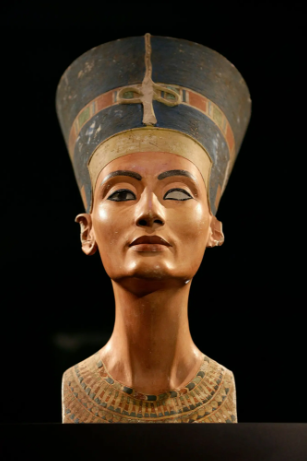
A bust of Nefertiti on display at the Neues Museum in Berlin in December 2012, during an exhibition marking the 100-year anniversary of the item’s discovery.Credit...Michael Sohn/Agence France-Presse, via Pool/Afp Via Getty Images
King Tut Died Long Ago, but the Debate About His Tomb Rages OnBy Franz Lidz
Published Oct. 30, 2022
Updated Oct. 31, 2022More than three millenniums after Tutankhamun was buried in southern Egypt, and a century after his tomb was discovered, Egyptologists are still squabbling over whom the chamber was built for and what, if anything, lies beyond its walls. The debate has become a global pastime.
At the center of the rumpus is the confrontational enthusiast Nicholas Reeves, 66, who shares a home near Oxford, England, with a nameless house cat. In July 2015, Dr. Reeves, a former curator at the British Museum and the Metropolitan Museum of Art, posited the tantalizing theory that there were rooms hidden behind the northern and western walls in the treasure-packed burial vault of Tutankhamun, otherwise known as King Tut.
It was long presumed that the small burial chamber, constructed 3,300 years ago and known to specialists as KV62, was originally intended as a private tomb for Tutankhamun’s successor, Ay, until Tutankhamun died prematurely at 19. Dr. Reeves proposed that the tomb was, in fact, merely an antechamber to a grander sepulcher for Tutankhamun’s stepmother and predecessor, Nefertiti. What’s more, Dr. Reeves argued, behind the north wall was a corridor that might well lead to Nefertiti’s unexplored funerary apartments, and perhaps to Nefertiti herself.
The Egyptian government authorized radar surveys using ground-penetrating radar that could detect and scan cavities underground. At a news conference in Cairo in March 2016, Mamdouh Eldamaty, then Egypt’s antiquities minister, showed the preliminary results of radar scans that revealed anomalies beyond the decorated north and west walls of the tomb, suggesting the presence of two empty spaces and organic or metal objects.
To much fanfare, he announced that there was an “approximately 90 percent” chance that something — “another chamber, another tomb” — was waiting beyond KV62. (Dr. Reeves said: “There was constant pressure from the press for odds. My own response was 50-50 — radar will either reveal there’s more to Tutankhamun’s tomb than we currently see, or it won’t.”)
Yet, two years and two separate radar surveys later, a new antiquities minister declared that there were neither blocked doorways nor hidden rooms inside the tomb. Detailed results of the final scan were not released for independent scrutiny. Nonetheless, the announcement prompted National Geographic magazine to withdraw funding for Dr. Reeves’s project and a prominent Egyptologist to say, “We should not pursue hallucinations.”
Zahi Hawass, Egypt’s onetime chief antiquities official and author of “King Tutankhamun: The Treasures of the Tomb,” said: “I completely disagree with this theory. There is no way in ancient Egypt that any king would block the tomb of someone else. This would be completely against all their beliefs. It is impossible!” (Dr. Reeves countered by pointing out that every successor king was responsible for closing the tomb of his predecessor, as the mythical Horus buried his father, Osiris. “This is even demonstrated in what we currently see on the burial chamber’s north wall — as labeled, Ay burying Tutankhamun,” Dr. Reeves said.)
Kara Cooney, a professor of Egyptian art and architecture at the University of California, Los Angeles, noted the fraught scholarly terrain. “Nick’s work is evidence-based and carefully researched,” she said. “But few Egyptologists will say it on record because they are all afraid of losing their access to tombs and excavation concessions. Or they are just plain jerks.”
Despite the setback, Dr. Reeves soldiered on. In “The Complete Tutankhamun: 100 Years of Discovery,” a freshly revised edition of his 1990 book to be published in January, he draws on data provided by thermal imaging, laser-scanning, mold-growth mapping and inscriptional analysis to support his fiercely debated scholarship. The provocative new evidence has bolstered his belief that Tutankhamun was given a hasty burial in the front hallway of the tomb of Nefertiti.
“Much of what Tutankhamun took to the grave had nothing to do with him,” said Dr. Reeves, who spoke by video from his home office. He maintained that King Tut had inherited a suite of lavish burial equipment that had then been repurposed to accompany him into the afterlife, including his famous gold death mask.
The father of Tutankhamun was Akhenaten, the so-called heretic king whose reign was characterized by social, political and religious upheaval. The 18th-dynasty pharaoh rejected Amun, Osiris and Egypt’s traditional gods in favor of a single disembodied creator-essence, Aten, or the sun disk. In the space of a generation, Akhenaten had created a city from scratch at el-Amarna for his new god, and prepared royal tombs for himself, his children and his wives, including Nefertiti.
After Akhenaten came an obscure pharaoh named Smenkhkare, whom Tutankhamun succeeded directly. Dr. Reeves has long held that Smenkhkare and Nefertiti were the same person, and that Akhenaten’s queen simply changed her name, first to Neferneferuaten, during a period of co-rule with her husband, and then to Smenkhkare following his death, navigating a period of sole, independent rule. To the boy-king would fall the burial of this rare woman pharaoh.
During King Tut’s decade-long reign, he appeared to have been largely occupied with rectifying the chaos bequeathed to him by his old man. But it would not be enough: Shortly after his death in 1,323 B.C., a new dynasty chiseled his tarnished name into dust.
Pyramid scheme
Dr. Reeves has conducted research directly in the tomb on several occasions over the years. He came to his theory about Tutankhamun in 2014 after examining high-resolution color photographs of the tomb, which were published online by Factum Arte, a company based in Madrid and Bologna, Italy, that specializes in art recording and replication. The images showed lines beneath the plastered surfaces of painted walls, suggesting uncharted doorways. He speculated that one doorway — in the west — opened into a Tutankhamun-era storeroom, and that another, which aligns with both sides of the entrance chamber, opened to a hallway continuing along the same axis in form and orientation reminiscent of a more extensive queen’s corridor tomb.“I saw early on, from the face of the north wall subject, that the larger tomb could only belong to Nefertiti,” Dr. Reeves said. “I also suggested, based on evidence from elsewhere, that the perceived storage chamber to the west of the burial chamber might have been adapted into a funerary suite for other missing members of the Amarna royal family.”
To support his radical reassessment, Dr. Reeves pointed to a pair of cartouches — ovals or oblongs enclosing a group of hieroglyphs — and a curious misspelling painted on the tomb’s north wall. The figure beneath the first cartouche is named as Tutankhamun’s Pharaonic successor, Ay, and is shown officiating at the young king’s burial carrying out the “opening the mouth” ceremony, a funerary ritual to restore the deceased’s senses — the ability to speak, touch, see, smell and hear. The key, Dr. Reeves said, is that both of the Ay cartouches show clear evidence of having been changed from their originals — the birth and throne names of Tutankhamun.
Dr. Reeves suggested that the cartouches had originally showed Tut burying his predecessor, and that the cartouches — and hence the tomb — were put to new use. “If you inspect the birth-name cartouche closely, you see clear, underlying traces of a reed leaf,” he said in an email. “Not by chance, this hieroglyph is the first character of the divine component of Tutankhamun’s name, ‘-amun,’ in all standard writings.”
Beneath Ay’s throne name may be discerned a rare, variant writing of Tutankhamun’s throne name, “Nebkheperure,” employing three scarab beetles. This is a variant whose lazy adaptation provides the only feasible explanation for the strangely misspelled three-scarab version of the Ay throne name “Kheperkheperure” that now stands there, Dr. Reeves said.
He deduced that the scene had originally depicted not Ay presiding over the interment of Tutankhamun, but Tutankhamun presiding over the burial of Nefertiti. There are two visual clinchers, he said. The first is the “rounded, childlike, double underchin” of the Ay figure, a feature not present in any image currently recognizable as him, implying that the original painting of the king must have been of the chubby, young Tutankhamun. The second is the facial contours of the mummified recipient — until now presumed to be Tutankhamun — whose lips, narrow neck and distinctive nasal bridge are a “perfect match” for the profile of the painted limestone bust of Nefertiti on display in the Neues Museum in Berlin.
“There would have been no reason to include a depiction of this predecessor’s burial in Tutankhamun’s own tomb,” Dr. Reeves said. “In fact, the presence of this scene identifies Tutankhamun’s tomb as the burial place of that predecessor, and that it was within her outer chambers that the young king had, in extremis, been buried.”
Rita Lucarelli, an Egyptologist at the University of California, Berkeley, said she had been following Dr. Reeves’s old and new claims with interest. “If he is right, it would be an amazing discovery because the tomb of Nefertiti would be intact, too,” she said. “But maybe even if there is a tomb there, it’s not that of Nefertiti, rather of another individual related to Tut. We simply cannot know it unless we dig through the bedrock.”
The problem, Dr. Lucarelli said, is finding a way to drill through the decorated north wall without destroying it. “This is also why other archaeologists do not sympathize with this theory,” she said.
Dr. Reeves’s unsympathetic colleagues are legion.
“Nick is flogging a dead horse in his theories,” Aidan Dodson, an Egyptologist at the University of Bristol, said. “He has provided no clear proof that the cartouches have been altered, and his iconographic arguments as to the faces on the wall have been rejected by pretty well every other Egyptologist I know of who is qualified to take a view.”
The politics of heritage
Dr. Cooney, whose book “When Women Ruled The World” argues that Nefertiti may have been Tut’s grandmother, is one of Dr. Reeves’s few champions. “I am not one of the many scholars laughing behind their hands,” she said. “Nick’s theory is brilliant but easily discounted in a very political and nationalistic Egypt that has refused to give permits to Western scholars who disagree with the party line. Maybe there’s nothing beyond the north wall of Tutankhamun’s tomb. Maybe it’s Al Capone’s safe. But if there is something there, this could potentially be the discovery of the millennium.”At least part of the backlash against Dr. Reeves’s ideas can be traced to the politics of heritage. The narrative that Tutankhamun’s tomb was unearthed by the heroic English archaeologist Howard Carter has long been openly challenged by Egyptians, who took the discovery as a rallying cry to end 1920s British rule and establish a modern Egyptian identity. Among Egyptologists today, the hot topics include the decolonization of the field and more inclusive and equitable accounts of Egyptian team members involved in archaeological excavations.
“Sure, some in Egypt take a different view from me, which is easy enough to understand,” Dr. Reeves said. A weary expression spread over his face. “Archaeologists in the U.K. would, I am sure, look askance at some foreigner sounding off on who might be buried in Westminster Abbey. But my sole interest as an academic Egyptologist, my intellectual responsibility, is to seek out the evidence and report honestly and as objectively as possible on what I find.”
Nefertiti’s burial is what the raft of new facts points toward when considered altogether, he said, and inevitably Nefertiti plus Tutankhamun is a big ask. “I can understand the skepticism with which my proposals have been greeted in some quarters,” he said. “And I initially shared it; I would spend a year testing and retesting my conclusions before feeling comfortable enough to publish.”
That was back in 2015, and Dr. Reeves believes the evidence now is stronger than ever. “Indeed, with the discovery that both cartouches of Ay overlie original cartouches of Tutankhamun, we have the veritable smoking gun,” he said. “To simply deny the evidence is not going to make it go away.”
ARTICLE
https://www.nytimes.com/2022/10/30/science/tutankhamen-nefertiti-archaeology.htmlMY THOUGHTS
I am a Nefertiti fan. Considering Akenaton is known as a radical leader of the nile, in that he went against the heritage and formed a new culture, i imagine his wife is radical in thinking as well. I can see her preparing for her son's time. The white man miscomprehends. He doesn't realize that the damage of his community, that being white scientist in africa is so vast that he is not trusted he is not wanted. He wants to be viewed as content of character but that is something anyone native in egypt must have a hard time doing based on an extensive negative past. It is that simple, the individualism some in the scholarly community want demands ignoring human history or specifically, interracial history, which is mostly or overwhelmingly negative in humanity.
-
Promptpot - a collage of prompts
The following is mine
https://www.deviantart.com/hddeviant/art/Promptpot-931555529
This is the Promptpot explanation
https://www.deviantart.com/hddeviant/art/PROMPTPOT-931556698-

day 21
https://www.deviantart.com/hddeviant/art/PromptPot2022-Day21-935153441
day 22
https://www.deviantart.com/hddeviant/art/Promptpot2022Day22-935154480
day 23
https://www.deviantart.com/hddeviant/art/Promptpot2022Day23-935154930
day 26
https://www.deviantart.com/hddeviant/art/Promptpot2022Day26-935155720
day 27
https://www.deviantart.com/hddeviant/art/Promptpot2022Day27-935155971
extra ingredient
https://www.deviantart.com/hddeviant/art/Promptpot2022ExtraIngredient-935156720
-
-

This year's Lena Baker Women's Health & Domestic Violence Summit will explore the mental health effects of continuous physical and psychological traumas that plagues American of the slavocracy system (ADOSS) through the music of Curtis Mayfield (Jun 03, 1942 - Dec 26, 1999). Mayfield was a prolific songwriter that wrote about being Black in America and black consciousness. We will explore Mayfield's most iconic songs that address internal colonization "We the People Are Darker Than Blue", Identity production "This Is My Country", and "People Get Ready". We will also explore the question, "Is there a time to heal?" with Mayfield's "Choice of Colors".
Min. Loretta Green-Williams
Summit Moderator
Postcolonial Theorist | Fd, CEO WOCPSCNSpecial Guest Speaker
Denise Jackson
COVID: Mental Health of Domestic Violence
Thursday, October, 27, 2022, 11 am est
Series One: "We Are People Darker Than Blue" When Colorism Destroys the HeartBased on the lyrics of Curtis Mayfield, this conversation will consider the difficulties of misogynoir, and colorism, among women of color.
THURSDAY, OCTOBER 27, 2022 12-noon pm est
Dr. Tamu Petra Browne
Growth & Innovation Coach for Women Entrepreneurs
Thursday, October 27, 2022Dr. LaTarsha Holden, MBA
Leadership Consultant | Author
Series Two: "This Is My Country": When They Share Their Care
This conversation will consider the physical and physiological trauma of racism and what it currently feels and looks like.FRIDAY, OCTOBER 28, 2022 12-noon est
Vaneese Johnson
Global Speaker | Author
Friday, October 28, 2022Desheen-in-the-chair-683x1024_edited.jpg
D'Sheene L. Evans
Visionarypreneur| Trauma Recovery Coach
The Trauma of Community
Friday, October 28, 2022
Series Three: "People Get Ready": When Being Sick Is When You Are Sick-n-Tired
"People Get Ready" was released the year of the voting rights act (1965), Americans that were descendants of the slavocratic system were given reason for optimism. However, with the reversal of recent American rights, and new traumatic occurrences, how do the people get ready when the train is derailed?
SATURDAY, OCTOBER 29, 2022 4:30 PM EST
Special Guest Speaker
Lola Russell, Ph.D.
Health Communications at CDC and Prevention
The Intersectionality of Trauma: Exploring the Patchwork of BeingDr. Mustafa Ansari
Dean Afro-Descendant Institute of Human Rights Chief Facilitator African Descendant NationSeries Four: "Choice of Colors": When the Horrors of History Claim We Are Still Americans
The US big city hate crimes spiked by 39% in 2021*, and with one of the more horrific racial crimes, the Buffalo shooting, the conversation will center around healing processes. Mayfield's "Choice of Colors" will be the foundation of discussion. We will consider the historic formations that has created the American construct of racism. We will discuss what components towards racial healing can be considered. We will also consider how we can move forward, "...in order to form a more perfect union,..(Preamble of the United. States of America Constitution, 1787)".
Sunday, October 30, 2022 4:30 PM EST
Joan Babiak
Moderator
Attorney |Board of Trustees Member
Sunday, October 30, 2022
Dr. Camelia Straughn
Transformational Coach | Author | International Speaker
Sunday, October 30, 2022
Lorlett Hudson FRSA
Leadership Coach | Working with African and Caribbean Leaders and Entrepreneurs -
Celebrity DJ’s Wife Faked Orgasms for 10 Years of Marriage because of ‘Not Knowing Her Own Body’
(Photo by Paras Griffin/Getty Images for BET)
Popular daily radio and vlog show, The Breakfast Club co-host DJ Envy and his wife Gia Casey have been in the news lately, and not for their job. Gia has admitted she had faked orgasms for 10 years of her marriage. It was something she said she did repeatedly and consistently. The couple sat down with The Shade Room to have an intimate chat and discuss their new book Real Life, Real Love: Life Lessons on Joy, Pain & the Magic That Holds Us Together.Casey started the conversation about her struggle to reach a climax with her husband because it is a part of the book, which is available now. The radio personality, as Casey shared, was her first and only because they met in high school.
“Most young girls and even many, many, many women, I’m sure so many women can relate, don’t know how to achieve an orgasm,” she said. “A lot of women have no idea what it feels like to have an orgasm through sexual intercourse.”
“We would be intimate and he would be putting his best foot forward…he lives to make me happy. So I would see him trying and really going to work,” she continued. “You want to reward that man for that work and the only reward that you have to offer is an orgasm. But even if I didn’t feel it, I would still be performative.”
In retrospect, Casey says she realized he couldn’t help her reach orgasm because she didn’t know what she needed to get there.
“He was doing everything a man could do to please a woman. The problem was, I didn’t know my own body,” she admitted.
This is more of a common problem for women than you think.
According to the published Journal of Sex and Marital Therapy, a whopping 81.6% of women don’t orgasm from intercourse alone (without additional clit stimulation). And nearly 15% of women have never orgasmed ever!
Not reaching an orgasm makes a great number of women feel inadequate, as if her sexual equipment is broken, leading her down a path of exploration to seek and find the BIG O. After trying many positions, reading self-help books and buying dozens of toys, some women remain unaware of exactly what an orgasm is and why it is so difficult to reach one. So the question is, why is it so difficult for women to reach orgasm when men seem to be able to reach sexual bliss so easily?The answer actually consists of a few parts:
1. Women need more than entry to orgasm.
Inserting part A into slot B is the typical sexual situation that the average couple believes will enable both partners to reach a climax, but in actuality women need more than vaginal penetration in order to reach an orgasm. About 70% of women need clitoral stimulation along with penetrative sex in order to reach an orgasm. The clitoris is made up of 8000 nerve endings making it the most sensitive body part on a woman, so it needs love and attention as does the rest of the body during sex!During penetration, the clitoris is stimulated from the inside because of its legs that extend deep into the vagina, but for most women that internal stimulation isn’t enough. DIRECT contact is where it’s at! Sex positions that position the pelvises close together, oral sex during foreplay or using a clitoral vibrator during sex are great ways to ensure clitorial stimulation is achieved during intercourse.
2. Women’s sexual energy starts in the brain.
Sexual energy is a vital source of energy that gives life to every living being on the Earth. When it comes to men and women, sexual energy originates in different parts of the body. In men, sexual energy originates in the pelvis, which explains why men are ready for sex in 20 seconds as opposed to the 10 minutes it typically takes a woman’s body to be ready for intercourse. Women’s sexual energy originates in the head, so in order for the genitals to be in a state of welcoming and wanting, the energy has to travel down the spine into the pelvis, and that is some distance to travel!
This fact is one that many women are unaware of, and furthermore, many women have no idea how to move the energy from the brain into the pelvis. Through meditation, concentrated breathing and focusing the mind on the pelvis, sexual energy can move from the brain into the genitals where it belongs during sex. This technique has to be learned and it takes some time to master, but once a woman knows how to transfer that energy where it needs to be, orgasm during sex can be achieved with ease every time.3. Women live in their heads
“What should I make for dinner tomorrow?” “I wonder what the kids are doing right now.” “OMG! I s he looking at my stretch marks?” “Ew, his breath smells like Doritos!” These thoughts and more are things that can roll through the minds of women during sex. Women tend to live in their heads and think about everything but sex during sexual experiences, which causes disconnect between the brain (where sexual energy originates for women) and the genitals that need to connect with the sexual energy. When the mind is everywhere else besides the moment of sexual pleasure, the body will not respond to the typical triggers that should send it into an orgasmic frenzy.
In order to bring the body closer to a climax, the mind needs to be cleared and freed of anything that isn’t sex within that moment. Meditation, a pre-performance massage, stretching or even a hot bath or shower are all great ways to mellow out before the fun begins. Leave all of the thoughts about work, children and body issues at the door. Leave the mind open to register touch, smells, sounds and every other sensation associated with the sexual rendezvous taking place in the moment. Live in the moment!Every woman has the parts necessary to orgasm and can learn how to achieve the greatest climax of her life; it just takes dedicated and focused intention and a little practice to get there.
April 27, 2022 by Tamara Gibson
ARTICLE
https://blackdoctor.org/dj-envy-wife-fake-orgasm/
MY THOUGHTS
I said the following a trillion times and I will say it a trillion and one, If you define virginity by first orgasm, most women are virgins into their 30s. ... I want to state other, most women in the usa are virgins based on the stated elemental into their 30s but outside the usa into their late 40s.
What is telling? Somehow this isn't common knowledge.
When a woman orgasm what happens? The vaginal walls pulse rapidly. This is to coax the penis to ejaculate. Saying the vagina will aid in pushing the sperm to the egg.
Why are vaginas tight? Lack of use. Girls, meaning any female who never was head of household, have no experience fornicating, thus tightness. Usually , women , meaning any female who lived or lives as head of household, has tightness if she has not fornicated in a long time, side another or with a tool. Tightness of vagina has nothing to do with vixen qualities. Think of the vagina like your leg. Have you ever sat down to o long and your leg started to cramp. Well that is something like a vagina unused for months. If someone told you to start running as fast as you can after sitting down without moving for hours it will hurt right? that is what happens when a vagina has a penis rummaging in it. The better thing for your leg is a massage to prepare to run. The vagina needs the same patient care when unused.
In the article the woman in question states a simple truth. No matter how much a man is gentle or caring, a woman may not orgasm. It isn't about being loved it is about knowing oneself. This knowing requires experimentation with one self.An eventually side the partner. Being great in bed as a couple demands the two learn what will make them great in bed. It can not be assumed or forced.
In terms of pleasure, everyone is unique in what gives them pleasure and how two people find pleasure is also unique, but in either case it takes time, trial and error to know.
-
Lupita Nyong'o On Why She Decided Not To Star In 'The Woman King'
Bre Williams
October 19, 2022Lupita Nyong’o is talking about why she decided to not star in The Woman King.
The actress was set to star alongside Davis in the upcoming historical film The Woman King. But back in 2020, the actress walked away from the film in which she was to play an Agojie warrior.
In a new interview with The Hollywood Reporter, Nyong’o opened up about why she decided against starring in Gina Prince-Bythewood’s film.
Nyong'o didn't feel like the role was right for her.
According to IndieWire, Nyong’o was set to play an Agojie warrior in The Woman King starring Viola Davis, who also produces. The Agojie tribe inspired the fictional Dora Milaje female army in Black Panther.After she was cast in the film, the actress made a short documentary about the Agojie tribe called “Warrior Women With Lupita Nyong’o.”
Per The Hollywood Reporter, the Academy Award winner “grapples uncomfortably with the tribe’s legacy of violence.” After the documentary, Nyong’o decision to exit The Woman King though she hasn’t specifically revealed why.“It was very amicable, the departure from it,” Nyong’o said. “But I felt it wasn’t the role for me to play.”
Thuso Mbedu took over the role Nyong’o was slated to play.
After her departure, Lupita Nyong’o’s role was given to Thuso Mbedu.In addition to The Woman King, Nyong’o also exited the upcoming Apple TV+ series Lady in the Lake, which stars Natalie Portman. Moses Ingram replaced her in that series.
“I’m desperate for small projects,” Nyong’o told THR. “They’re harder to get off the ground, they’re harder to stay on track. Bigger movies elbow them out of the way. The pandemic and the fiscal stress on the industry has made it even harder for those movies to get made.”
Nyong'o is currently balancing large projects with smaller independent roles.
“I think to be culturally prosperous, to be artistically prosperous as a people, is to have options. I personally love a good Marvel movie, but it doesn’t take me away from really wanting the little character-driven film,” the Us actress shared. “I believe in the fight for those things to be kept alive because the one thing we always want, the ultimate privilege, is choice.”She concluded, “It becomes a philosophical question about what is art and what is its purpose. I believe that art plays a role in moving the people that experience it, and a lot of people are moved by Marvel. Is you being moved by this thing less important than me being moved by Picasso?”
Bre Williams
October 19, 2022ARTICLE
https://shadowandact.com/lupita-nyongo-on-why-she-decided-not-to-star-in-the-woman-king
THE BLACK DRAGON'S REVENGE - RON VAN CLIEF - FULL HD MARTIAL ARTS MOVIE IN ENGLISH
imdb
https://www.imdb.com/title/tt0072858/?ref_=nm_flmg_act_16
film
LINK
https://www.youtube.com/watch?v=VeOoWRtASY4Is Kanye Finally CANCELED? from Bad Faith
LINK
https://youtu.be/wxHAm-bgFyM
Referral
https://twitter.com/msolurin/status/1580952441839026179
Art Block and Burnout from chrissa bug
LINK
https://youtu.be/e_tYHhkjC4s
REFERRAL
https://www.deviantart.com/chrissabug/status-update/New-Video-about-Art-Block-93374057228 Stories You Can Read Online for Black History Month
“Anything Could Disappear“
By Danielle Evans
Electric Literature
https://electricliterature.com/anything-could-disappear-danielle-evans/“Drinking Coffee Elsewhere“
By Z.Z. Packer
The New Yorker
https://www.newyorker.com/magazine/2000/06/19/drinking-coffee-elsewhere“The Era“
By Nana Kwame Adjei-Brenyah
Guernica
https://www.guernicamag.com/the-era/“Suicide, Watch“
By Nafissa Thompson-Spires
Dissent Magazine
https://www.dissentmagazine.org/article/suicide-watch-heads-colored-people-social-media“French Absolutism“
By Brandon Taylor
Joyland
https://joylandmagazine.com/fiction/french-absolutism/“What’s For Sale“
By Nicole Dennis-Benn
Kweli Journal
http://www.kwelijournal.org/fiction/2014/5/14/whats-for-sale-by-nicole-y-dennis-benn?rq=What's“Sunflowers“
By Bryan Washington
Boston Review
http://bostonreview.net/fiction/bryan-washington-sunflowers“Dangerous Deliveries“
By Sidik Fofana
Epiphany
https://epiphanyzine.com/features/dangerous-deliveries-fofana“Williamsburg Bridge“
By John Edgar Wideman
Harper’s Magazine
https://harpers.org/archive/2015/11/williamsburg-bridge/“The Key“
By Nnedi Okorafor
Enkare Review
https://enkare.org/2016/11/14/key-nnedi-okorafor/“Milk Blood Heat“
By Dantiel W. Moniz
Ploughshares
https://www.pshares.org/issues/spring-2018/milk-blood-heat“Bear Bear Harvest“
By Venita Blackburn
Virginia Quarterly Review
https://www.vqronline.org/fiction/2018/12/bear-bear-harvest“Beg Borrow Steal“
By Maurice Carlos Ruffin
Kenyon Review Online
https://kenyonreview.org/kr-online-issue/2015-summer/selections/maurice-carlos-ruffin-342846/“How to Kill Gra’ Coleman and Live to Tell About It (Vauxhall, NJ, c. 1949)“
By Kim Coleman Foote
Missouri Review
https://www.missourireview.com/how-to-kill-gra-coleman-and-live-to-tell-about-it-vauxhall-nj-c-1949-by-kim-coleman-foote/“Allentown, Saturday“
By Gabriel Bump
Brooklyn Rail
https://brooklynrail.org/2020/06/fiction/Allentown-Saturday“Books and Roses“
By Helen Oyeyemi
Granta
https://granta.com/books-and-roses/“God’s Gonna Trouble the Water“
By Randall Kenan
Oprah Magazine
https://www.oprahmag.com/entertainment/books/a33350187/randall-kenan-short-story-gods-gonna-trouble-the-water/“What It Means When a Man Falls From the Sky“
By Lesley Nneka Arimah
Catapult
https://catapult.co/stories/some-mathematicians-remove-pain-some-of-us-deal-in-negative-emotions-we-all-fix-the-equation-of-a-person“The City Born Great“
By N.K. Jemisin
Tor.com
https://www.tor.com/2016/09/28/the-city-born-great/“202 Checkmates“
By Rion Amilcar Scott
Electric Literature
https://electricliterature.com/202-checkmates-by-rion-amilcar-scott/“All This Want and I Can’t Get None“
By Tia Clark
Joyland
https://joylandmagazine.com/fiction/all-this-want-and-i-cant-get-none/“Wet Paper Grass“
By Jasmon Drain
Terrain
https://www.terrain.org/fiction/26/drain.htm“Emperor of the Universe“
By Kaitlyn Greenidge
Kweli Journal
http://www.kwelijournal.org/fiction/2014/10/10/emperor-of-the-universe-by-kaitlyn-greenidge“Ark of Light“
By Victor LaValle
Lightspeed Magazine
https://www.lightspeedmagazine.com/fiction/ark-of-light/“False Cognates“
By Ladee Hubbard
Guernica
https://www.guernicamag.com/false-cognates-1991/“Whiskey & Ribbons“
By Leesa Cross-Smith
Carve Magazine
https://www.carvezine.com/story/2011-fall-cross-smith“A Selfish Invention“
By Donald Quist
Storychord
http://www.storychord.com/2017/03/issue-140-donald-edem-quist-tracy.html“Best Features“
By Roxane Gay
Barrelhouse
https://www.barrelhousemag.com/onlinelit/2010/11/1/best-featuresARTICLE
https://chireviewofbooks.com/2021/02/01/28-stories-you-can-read-online-for-black-history-month/ -
Promptpot - a collage of prompts
The following is mine
https://www.deviantart.com/hddeviant/art/Promptpot-931555529
This is the Promptpot explanation
https://www.deviantart.com/hddeviant/art/PROMPTPOT-931556698 -
Promptpot - a collage of prompts
The following is mine
https://www.deviantart.com/hddeviant/art/Promptpot-931555529
This is the Promptpot explanation
https://www.deviantart.com/hddeviant/art/PROMPTPOT-931556698-

Day14
Marionette of Promptpot 01 - I thought of a marionette in reverse. From the ground to above.
https://www.deviantart.com/hddeviant/art/Promptpot2022Day14-933290001Day 15
Your Fav Ship of Promptpot 01 - Not my favorite, but a ship I always felt I wish I could had a hand in designing... the land boat from the film , age of dragons..
https://www.deviantart.com/hddeviant/art/Promptpot2022Day15-933290278Day 16
Rot of Promptpot 01 - Well, rot is decomposition. Where carbon based lifeforms, like humans, deteriorate. Carbon based lifeforms give off carbon dioxide. Can you tell what is going on?
https://www.deviantart.com/hddeviant/art/Promptpot2022Day16-933290543
-
-
Title: Haitian Goddess 2
Artist: Chevelin Pierre
https://www.deviantart.com/chevelinpierre/art/Haitian-goddess-2-932906268Watch the work made! magic!!
How to draw a fantasy merchant lady, in european terms a centaur, but I can see a woman with a fish tail
What say you to Chevelin?
Read a South Carolinian mermaid tale
https://aalbc.com/tc/profile/6477-richardmurray/?status=1614&type=status
An example of some of Chevelin's full colored illustrations, lovely work
@chevelin_illustration Drawing by @chevelin
♬ Stuck In The Middle - Tai VerdesWARNING: If you have a problem with nudity, do not look or play the following video. Otherwise, enjoy Danto
P.S.
We don't Talk About Gabriella?
https://aalbc.com/tc/profile/6477-richardmurray/?status=2086&type=status -
Promptpot - a collage of prompts
The following is mine
https://www.deviantart.com/hddeviant/art/Promptpot-931555529
This is the Promptpot explanation
https://www.deviantart.com/hddeviant/art/PROMPTPOT-931556698 -
Promptpot - a collage of prompts
The following is mine
https://www.deviantart.com/hddeviant/art/Promptpot-931555529
This is the Promptpot explanation
https://www.deviantart.com/hddeviant/art/PROMPTPOT-931556698-

Day 9
Steampunk of Promptpot 01 - The plans for a motorized tricycle, powered by spirits physical energy.
https://www.deviantart.com/hddeviant/art/Promptpot2022Day09-932661011Day 10
Pills of Promptpot 01 - Traditional pills created with ingredients of death.
https://www.deviantart.com/hddeviant/art/Promptpot2022Day10-932661347Day 11
Teddy Friend of Promptpot 01 - A Gothic Lolita with her favorite Teddy. What are your thoughts to her relationship to him?
https://www.deviantart.com/hddeviant/art/Promptpot2022Day11-932661559
-
-
Create a beast
ok
The template
Layout your lair, coming soon
-
Create a beast
ok
The template
Layout your lair, coming soon
-
Promptpot - a collage of prompts
The following is mine
https://www.deviantart.com/hddeviant/art/Promptpot-931555529
This is the Promptpot explanation
https://www.deviantart.com/hddeviant/art/PROMPTPOT-931556698 -
My DTIYS for Chrissabug 10,000 followers on deviantart
https://www.deviantart.com/hddeviant/art/Chrissabugdtiys10k2022-Invitation-932158374Poem: THe Truth To The Green Woman Legend
Author: Richard Murray
https://www.kobo.com/us/en/audiobook/the-truth-to-the-green-woman-legendColored version of Chrsisabugdtiys 10k invitational
https://www.deviantart.com/hddeviant/art/Chrissabugdtiys10k2022-colored-version-932273345showcase
I am 1:38:13 to 1:39:06
-
Promptpot - a collage of prompts
The following is mine
https://www.deviantart.com/hddeviant/art/Promptpot-931555529
This is the Promptpot explanation
https://www.deviantart.com/hddeviant/art/PROMPTPOT-931556698 -
Promptpot - a collage of prompts
The following is mine
https://www.deviantart.com/hddeviant/art/Promptpot-931555529
This is the Promptpot explanation
https://www.deviantart.com/hddeviant/art/PROMPTPOT-931556698




